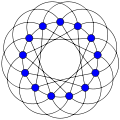Graph automorphism
In the mathematical field of graph theory, an automorphism of a graph is a form of symmetry in which the graph is mapped onto itself while preserving the edge–vertex connectivity.
Formally, an automorphism of a graph G = (V, E) is a
Computational complexity
Constructing the automorphism group of a graph, in the form of a list of generators, is polynomial-time equivalent to the graph isomorphism problem, and therefore solvable in quasi-polynomial time, that is with running time for some fixed .[3][4] Consequently, like the graph isomorphism problem, the problem of finding a graph's automorphism group is known to belong to the

The easier problem of testing whether a graph has any symmetries (nontrivial automorphisms), known as the graph automorphism problem, also has no known
Algorithms, software and applications
While no worst-case polynomial-time algorithms are known for the general Graph Automorphism problem, finding the automorphism group (and printing out an irredundant set of generators) for many large graphs arising in applications is rather easy. Several open-source software tools are available for this task, including NAUTY,[9] BLISS[10] and SAUCY.[11][12] SAUCY and BLISS are particularly efficient for sparse graphs, e.g., SAUCY processes some graphs with millions of vertices in mere seconds. However, BLISS and NAUTY can also produce Canonical Labeling, whereas SAUCY is currently optimized for solving Graph Automorphism. An important observation is that for a graph on n vertices, the automorphism group can be specified by no more than generators, and the above software packages are guaranteed to satisfy this bound as a side-effect of their algorithms (minimal sets of generators are harder to find and are not particularly useful in practice). It also appears that the total support (i.e., the number of vertices moved) of all generators is limited by a linear function of n, which is important in runtime analysis of these algorithms. However, this has not been established for a fact, as of March 2012.
Practical applications of Graph Automorphism include
Symmetry display
Several graph drawing researchers have investigated algorithms for drawing graphs in such a way that the automorphisms of the graph become visible as symmetries of the drawing. This may be done either by using a method that is not designed around symmetries, but that automatically generates symmetric drawings when possible,[13] or by explicitly identifying symmetries and using them to guide vertex placement in the drawing.[14] It is not always possible to display all symmetries of the graph simultaneously, so it may be necessary to choose which symmetries to display and which to leave unvisualized.
Graph families defined by their automorphisms
Several families of graphs are defined by having certain types of automorphisms:
- An asymmetric graph is an undirected graph with only the trivial automorphism.
- A vertex-transitive graph is an undirected graph in which every vertex may be mapped by an automorphism into any other vertex.
- An edge-transitive graph is an undirected graph in which every edge may be mapped by an automorphism into any other edge.
- A symmetric graph is a graph such that every pair of adjacent vertices may be mapped by an automorphism into any other pair of adjacent vertices.
- A distance-transitive graph is a graph such that every pair of vertices may be mapped by an automorphism into any other pair of vertices that are the same distance apart.
- A semi-symmetric graph is a graph that is edge-transitive but not vertex-transitive.
- A half-transitive graph is a graph that is vertex-transitive and edge-transitive but not symmetric.
- A skew-symmetric graph is a directed graph together with a permutation σ on the vertices that maps edges to edges but reverses the direction of each edge. Additionally, σ is required to be an involution.
Inclusion relationships between these families are indicated by the following table:
 |
 |
 | ||
| distance-transitive | distance-regular | strongly regular | ||
 |
 |
|||
| symmetric (arc-transitive) | t-transitive, t ≥ 2 | |||
 |
 |
 | ||
| vertex- and edge-transitive | edge-transitive and regular | edge-transitive | ||
 |
 |
|||
| vertex-transitive | regular | |||
 |
||||
| Cayley graph |
See also
References
- Zbl 0020.07804.
- S2CID 124723321.
- ^ .
- arXiv:1710.04574 [math.GR].
- ^ MR 0605600.
- .
- OCLC 246882287
- ^ doi:10.1137/S009753970241096X. Archived from the original(PDF) on 2008-11-20. Retrieved 2010-03-10.
- ^ McKay, Brendan (1981), "Practical Graph Isomorphism" (PDF), Congressus Numerantium, 30: 45–87, retrieved 14 April 2011.
- ^ Junttila, Tommi; Kaski, Petteri (2007), "Engineering an efficient canonical labeling tool for large and sparse graphs" (PDF), Proceedings of the Ninth Workshop on Algorithm Engineering and Experiments (ALENEX07).
- S2CID 15629172, archived from the original(PDF) on 2021-01-26, retrieved 2011-04-14.
- ^ Katebi, Hadi; Sakallah, Karem; Markov, Igor L. (July 2010), "Symmetry and Satisfiability: An Update" (PDF), Proc. Satisfiability Symposium (SAT).
- .
- ISBN 978-3-540-43309-5.







